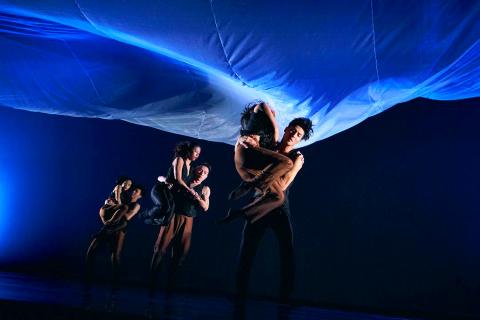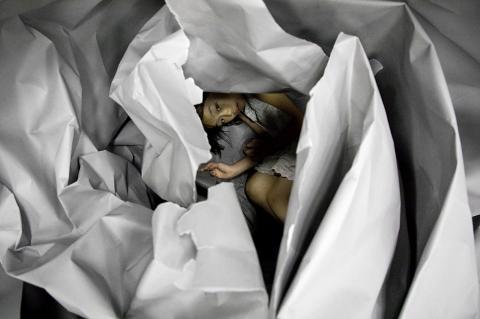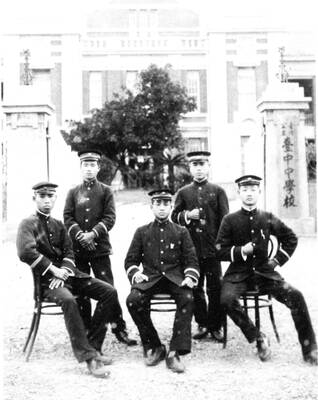Artistic endeavors are often described as flights of fancy. Two works that will be performed in Taipei this weekend definitely fit that description: Taipei-based WCdance’s (林文中舞團) The Wind Rises (風起) and After Game (遊戲之後) by Feng Dance Theater (風乎舞雩), a small company whose name comes from a passage about breezes in The Analects of Confucius.
Choreographer Lin Wen-chung (林文中) has long been inspired by flight. He drew on his teenage love of model airplanes for his 2015 work, Aerodynamics (空氣動力學), while his latest creation, The Wind Rises, was inspired by Japanese artist and director Hayao Miyazaki’s 2014 anime film of the same name.
The film was a semi-fictional biography of aeronautical engineer Jiro Horikoshi, who designed the Zero fighter and other military aircraft. For the title, Miyazaki drew on a line from Paul Valery’s poem Le Cimetiere Marin (The graveyard by the sea): “The wind is rising! We must try to live.”

Photo courtesy of Lin Ting Tai
“The director [Miyazaki] combined two stories, one about the designer of the planes used in kamikaze attacks and how he fell in love with a girl who was ill and passed away. It is about how people pursue their dreams and costs,” Lin said in a telephone interview on Monday.
“It’s very different from my previous works … friends say it is more emotional. My pieces are usually more cool,” Lin said.
“I don’t what made this change, time or maybe my age,” he joked.

Photo Courtesy of Feng Dance Theater
He recruited some of the same team that worked on Aerodynamics, including composer Lin Fang-yi (林芳宜) and multi-media artist Ethan Wang (王奕盛).
However, this time around Wang did not create projections, but designed the set.
“This time he is behind the scenes. He told me to save money, keep it simple, since the projectors needed for his usual projections are very expensive,” Lin said. “The stage is beautiful.”
In an usual move for his company, Lin premiered The Wind Rises on Saturday last week in Hsinchu. However, it was another pragmatic decision, like simplifying the stage: the Hsinchu Performing Arts Center let him use the theater for two weeks of rehearsal, an amount of time that is rare in Taiwan’s performing world.
Costs are a concern because Lin has basically outgrown the Experimental Theater at the National Theater, where his company performed for its first few years. The black-box space has seating for just about 240 people.
This time around the two shows in Taipei will be at the Metropolitan Hall, a mid-sized stage, but with seating for about 1,000, which means Lin has a lot of tickets to sell. The company is doing fairly well on that front; there are just about 300 seats left for each of the two shows.
One company that has not yet outgrown the Experimental Theater is Feng Dance.
The 12-year-old Tainan-based company premiered its newest production, After Game, at the Tainan Municipal Cultural Center on Nov. 25.
It will be at the Experimental Theater for three shows, starting on Saturday afternoon.
Choreographed by the troupe’s artistic director, Dominique Yen (顏鳳曦), After Game is an exploration of life and death as seen through the eyes of children and parents.
Children often ask questions that adults find difficult to answer, such as “Where do we come from?” and “What happens after you die?” They often use games or play to resolve the challenges they encounter.
Yen was interested in exploring how to answer such questions, both as an artist and as a mother; how to think about the meaning of life in a creative way and how to teach children about cherishing life’s little moments.
In addition to creating works for her company and other troupes, Yen, who is an assistant professor of dance at the Tainan University of Technology, has been a frequent contributor to Kaohsiung City Ballet’s (高雄城市芭蕾舞團) annual Dance Shoe (點子鞋) production, with pieces that reflect the best of ballet and modern dance traditions.
In other dance-related news, congratulations are in order for Century Contemporary Dance Company (世紀當代舞團) founder Yao Shu-fen (姚淑芬). She was named on Tuesday one of the seven winners of this year’s National Award for Arts by the National Culture and Arts Foundation.

April 28 to May 4 During the Japanese colonial era, a city’s “first” high school typically served Japanese students, while Taiwanese attended the “second” high school. Only in Taichung was this reversed. That’s because when Taichung First High School opened its doors on May 1, 1915 to serve Taiwanese students who were previously barred from secondary education, it was the only high school in town. Former principal Hideo Azukisawa threatened to quit when the government in 1922 attempted to transfer the “first” designation to a new local high school for Japanese students, leading to this unusual situation. Prior to the Taichung First

Chinese Nationalist Party (KMT) Chairman Eric Chu (朱立倫) hatched a bold plan to charge forward and seize the initiative when he held a protest in front of the Taipei City Prosecutors’ Office. Though risky, because illegal, its success would help tackle at least six problems facing both himself and the KMT. What he did not see coming was Taipei Mayor Chiang Wan-an (將萬安) tripping him up out of the gate. In spite of Chu being the most consequential and successful KMT chairman since the early 2010s — arguably saving the party from financial ruin and restoring its electoral viability —

The Ministry of Education last month proposed a nationwide ban on mobile devices in schools, aiming to curb concerns over student phone addiction. Under the revised regulation, which will take effect in August, teachers and schools will be required to collect mobile devices — including phones, laptops and wearables devices — for safekeeping during school hours, unless they are being used for educational purposes. For Chang Fong-ching (張鳳琴), the ban will have a positive impact. “It’s a good move,” says the professor in the department of

Article 2 of the Additional Articles of the Constitution of the Republic of China (中華民國憲法增修條文) stipulates that upon a vote of no confidence in the premier, the president can dissolve the legislature within 10 days. If the legislature is dissolved, a new legislative election must be held within 60 days, and the legislators’ terms will then be reckoned from that election. Two weeks ago Taipei Mayor Chiang Wan-an (蔣萬安) of the Chinese Nationalist Party (KMT) proposed that the legislature hold a vote of no confidence in the premier and dare the president to dissolve the legislature. The legislature is currently controlled